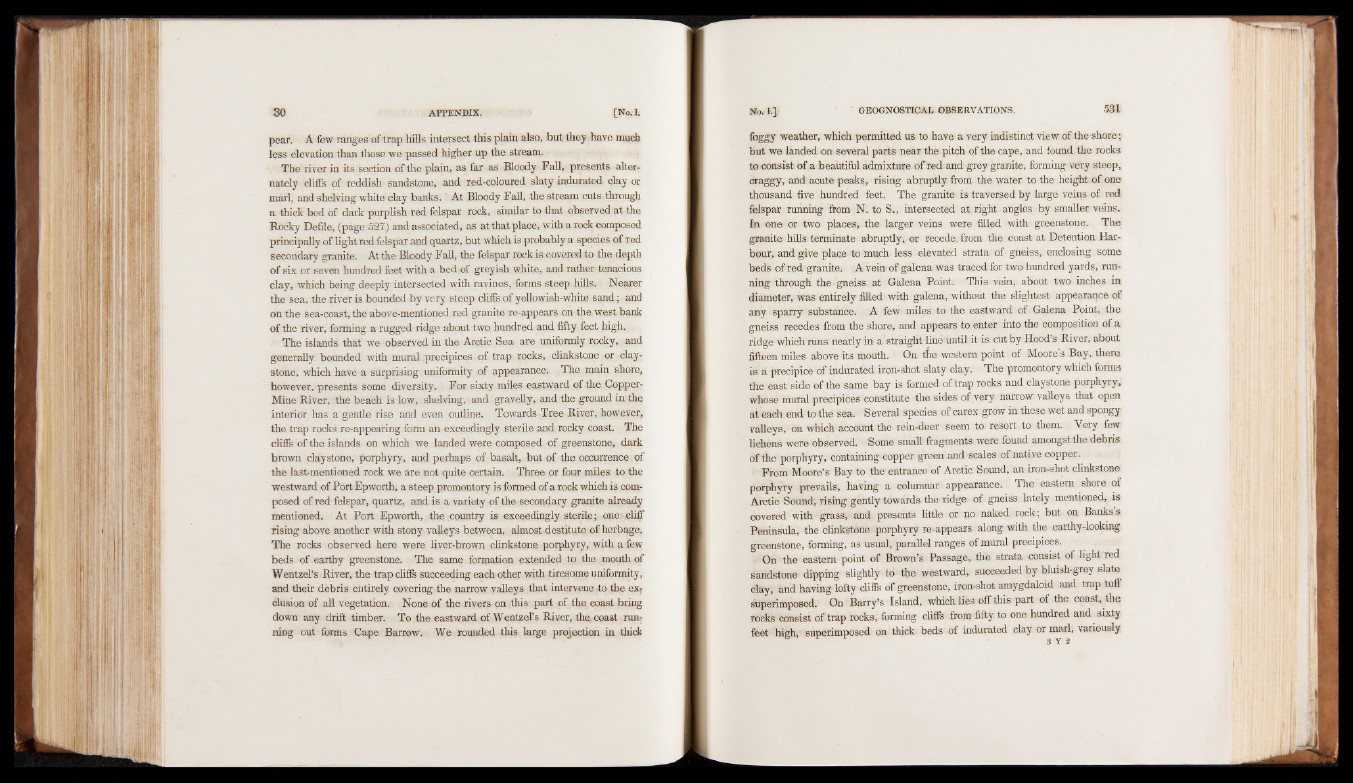
pear. A few ranges of trap hills intersect this plain also, but they have much
less elevation than those we passed higher up the stream.
The river in its section of the plain, as far as Bloody Fall, presents alternately
elifis of reddish sandstone, and red-coloured slaty indurated clay or
marl, and shelving white clay banks. At Bloody Fall, the stream cuts through
a thick bed of dark purplish red felspar rock, similar to that observed at the
Rocky Defile, (page 527) and associated, as at that place, with a rock composed
principally of light red felspar and quartz, but which is probably a species of red
secondary granite. At the Bloody Fall, the felspar rock is covered to the depth
of six or seven hundred feet with a bed of greyish white, and rather tenacious
clay, which being deeply intersected with ravines, forms steep hills. Nearer
the sea, the river is bounded by very steep cliffs of yellowish-white sand ; and
on the sea-coast, the above-mentioned red granite re-appears on the west bank
of the river, forming a rugged ridge about two hundred and fifty feet high.
The islands that we observed in the Arctic Sea are uniformly rocky, and
generally bounded with mural precipices of trap rocks, clinkstone or clay-
stone, which have a surprising uniformity of appearance. The main shore,
however, presents some diversity. For sixty miles eastward of the Copper-
Mine River, thé beach is low, shelving, and gravelly, and the ground in the
interior has a gentle rise and even outline. Towards Tree River, however,
the trap rocks re-appearing form an exceedingly sterile and rocky coast. The
cliffs of the islands on which we landed were composed of greenstone, dark
brown claystone, porphyry, and perhaps of basalt, but of the occurrence of
the last-mentioned rock we are not quite certain. Three or four miles to the
westward of Port Epworth, a steep promontory is formed of a rock which is composed
of red felspar, quartz, and is a variety of the secondary granite already
mentioned. At Port Epworth, the country is exceedingly sterile ; one7 cliff
rising above another with stony-valleys between, almost destitute of herbage.
The rocks observed here were liver-brown clinkstone porphyry, with a few
beds of earthy greenstone. The same formation extended to the mouth of
Wentzel’s River, the trap elifis succeeding each other with tiresome uniformity,
and their debris entirely covering the narrow valleys that intervene do the ex?
elusion of all vegetation. None of the rivers on this part of the coast bring
down any drift timber. To the eastward of Wentzel’s River, the coast runT
ning out forms Cape Barrow. We rounded this large projection in thick
foggy weather, which permitted us to have a very indistinct view of the shore;
but we landed on: several parts near the pitch of the cape, and found, the rocks
to consist of a beautiful admixture of red and grey granite, forming very steep,
craggy, and acute peaks, rising abruptly from the water to the height of one
thousand five hundred feet. The granite is traversed by large veins of red
felspar running from N. to S., intersected at right angles by smaller veins.
In one or two places, the larger veins were filled with greenstone. The
granite hills terminate abruptly, or recede, from the coast at Detention Harbour,
and give place to much less elevated strata of gneiss, enclosing some
beds of red granite. A vein of galena was traced for two hundred yards, running
through the gneiss at Galena Point. This vein, about two inches in
diameter, was entirely filled with galena, without the slightest appearance of
any sparry substance. A few miles to the eastward of Galena Point, the
gneiss recedes from the shore, and appears to enter into the composition of a
ridge which runs nearly in a straight line until it is cut by Hood’s River, about
fifteen miles above its mouth. On the western point of Moore’s Bay, there
is a precipice of indurated iron-shot slaty clay. The promontory which forms
the east side of the same bay is formed of trap rocks and claystone porphyry,
whose mural precipices7 constitute the sides of very narrow valleys that open
at each end to the sea. Several species of carex grow in these wet and spongy
valleys, on which account the rein-deer seem to resort.to them. Very few
lichens were observed. Some small fragments were found amongst the debris
of the porphyry, containing copper green and scales of native copper.
From Moore’s Bay to the entrance of Arctic Sound, an iron-shot clinkstone
porphyry prevails, having a columnar appearance. The eastern shore of
Arctic Sound, rising gently towards the ridge of gneiss lately mentioned, is
covered with grass, and presents little or no naked rock; but on Bankss
Peninsula, the clinkstone porphyry re-appears along with the earthy-looking
greenstone, forming, as usual, parallel ranges of mural precipices.
On the eastern point of Brown’s Passage, the strata consist of light red
sandstone dipping slightly to the westward, succeeded by bluish-grey slate
clay, and having lofty cliffs of greenstone, iron-shot amygdaloid and trap tuff
superimposed. On Barry’s Island, which lies off this part of the coast, the
rocks consist of trap rocks, forming cliffs from fifty to one hundred and sixty
feet high, superimposed on thick beds of indurated clay or marl, variously